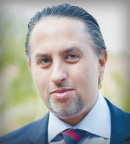The results of SWOG S18011 were met with enthusiasm by attendees at the Presidential Symposium of the European Society for Medical Oncology (ESMO) Congress 2022. The ASCO Post captured the thoughts of several melanoma experts, who had somewhat different ideas about the immediate clinical application of the findings.
Enthusiastic Response

Alexander M.M. Eggermont, MD
Alexander M.M. Eggermont, MD, principal investigator of the KEYNOTE-054 trial of adjuvant pembrolizumab, which was recently updated,2 said the results of SWOG S1801 “should be embraced by the medical community,” with no need for additional head-to-head trials. Dr. Eggermont is Professor of Oncology at Paris-Saclay University and Chief Scientific Officer at the Princess Maxima Center for Pediatric Oncology in the Netherlands.
“At the same 18 doses, at the same cost, you get a much better outcome—and you see that very rarely,” he commented from the audience. KEYNOTE-054’s initial hazard ratio for recurrence-free survival was 0.57.3 By his calculations, had SWOG S1801 compared its neoadjuvant regimen with placebo, KEYNOTE-054 did, “you’re looking at a hazard ratio of 0.35. We have never ever seen that,” he commented.
Words of Caution
A more cautious approach was voiced by Omid Hamid, MD, Director of the Melanoma Center and Phase I Immuno-Oncology Program at The Angeles Clinic and Research Institute, a Cedars-Sinai affiliate, Los Angeles. He said in an interview that although the study “clearly showed benefit,” there are some caveats and considerations.

Omid Hamid, MD
First, SWOG S1801 is smaller than most adjuvant trials in this setting. We await the overall survival data. Second, it is unclear whether it evaluated the most optimal neoadjuvant regimen, he said. For example, in the OpACIN-neo trial, ipilimumab plus nivolumab yielded a higher pathologic complete response rate, 78%.4
“But what the study does show is a regimen that we’re all comfortable with, and one that can translate to the community very easily, since we use pembrolizumab for many cancers. It doesn’t delay surgery or have negative outcomes. So, yes, with these data, we should run out and utilize this regimen,” Dr. Hamid said.
Primarily, the findings provide “a clear mandate to explore the neoadjuvant paradigm further,” he added. “It’s an indication of the possibilities of neoadjuvant therapy in a wide range of situations and tumors—in academic centers and in community practice.”
He said the study reinforces foundational work showing that neoadjuvant therapy offers us a gateway to understand a patient’s tumor and to study prognostic and predictive markers of response. The emerging use of circulating tumor DNA, for example, “has to be placed in the context of tumor response” to be useful, he noted.
Given the fact that SWOG S1801 data are encouraging and validate neoadjuvant therapy, Dr. Hamid would encourage clinicians to continue enrolling patients with stage III resectable melanoma to clinical trials evaluating combinatorial neoadjuvant immunotherapy doublets and triplets. Examples include KEYMAKER-U02 (ClinicalTrials.gov identifier NCT04303169), with a pembrolizumab backbone; MORPHEUS (NCT05116202), which is evaluating atezolizumab-based regimens; and NADINA (NCT04949113), which is evaluating ipilimumab/nivolumab neoadjuvant vs adjuvant nivolumab therapy.
“What I stress is that these trials will answer a lot of questions,” Dr. Hamid continued. “One, what does the lack of response mean to a patient? For example, if a patient with BRAF-mutant disease has no response in the neoadjuvant setting, should we be switching to a different adjuvant therapy? Two, if the patient has a major pathologic response—less than 10% of cells left—can we stop there and not need adjuvant therapy? Those are important questions to be asked. SWOG S1801 doesn’t answer those questions. Although the data are very strong, we still need to push the field forward through clinical trials.”
While awaiting clarification on such issues, Dr. Hamid usually restricts neoadjuvant immunotherapy to the clinical trial setting, though he discusses it with patients who are not eligible for a trial.
Additional Commentary

James Larkin, PhD
Invited discussant James Larkin, PhD, a clinical researcher at The Royal Marsden Hospital, London, said SWOG S1801 is “a landmark trial with a simple and powerful design” and striking results. However, he noted, the patient population was smaller than originally planned, the BRAF-mutant subset was underrepresented, and the control arm underperformed in comparison to adjuvant nivolumab in CheckMate 238.5 [After the ESMO meeting, S1801 lead author Sapna P. Patel, MD, explained to The ASCO Post that CheckMate 238’s endpoint was recurrence-free survival, which counts events starting after adjuvant therapy, whereas S1801’s endpoint was event-free survival, which counts events that occur before surgery [appropriate for a neoadjuvant trial], which would therefore result in a lower survival than the estimate based on CheckMate 238.]
Dr. Larkin posed some future questions for this treatment approach:
- What is the optimal duration of neoadjuvant treatment, and can it be individualized?
- How much postoperative treatment is needed, and can this be determined by pathologic assessment?
- Can surgery be safely avoided in some patients?
- Would the approach be optimized by the inclusion of ipilimumab?
“By extension, this paradigm provides a great platform for testing new agents, including combinations in cases where anti–PD-1 therapy is not sufficient to achieve a sufficient response,” Dr. Larkin added. “In the future, trials addressing these questions hand us a major opportunity to individualize and rationally de-escalate treatment.”
DISCLOSURE: Dr. Eggermont has served as a consultant to Agenus, BioInvent, CatalYm, Clover, Ellipses, Galecto, IO Biotech, IQVIA France, Merck, Pfizer, SalRoPa, Skyline, TigaTx, and Trained Therapeutics TTX. Dr. Hamid reported financial relationships with Array BioPharma, Bristol Myers Squibb, Novartis, Sanofi/Regeneron, Aduro, Akeso, Amgen, BeiGene, Genentech, GlaxoSmithKline, Immunocore, Incyte, Janssen, Merck, NextCure, Roche, Seattle Genetics, Tempus, and Zelluna. Dr. Larkin reported financial relationships with Eisai, Novartis, Merck, Pfizer, BMS, iOnctura, Debiopharm, Incyte, MSD, Pierre Fabre, Ipsen, Roche, EUSA Pharma, AstraZeneca, GSK, Calithera, Ultimovacs, Seagen, and Nektar Therapeutics.
REFERENCES
1. Patel S, Othus M, Prieto V, et al: Neoadjuvuant versus adjuvant pembrolizumab for resected stage III-IV melanoma (SWOG S1801). ESMO Congress 2022. Abstract LBA6. Presented September 11, 2022.
2. Eggermont AMM, Kicinski M, Blank CU, et al: Five-year analysis of adjuvant pembrolizumab or placebo in stage III melanoma. NEJM Evidence. Published September 10, 2022.
3. Eggermont AMM, Blank CU, Mandala M, et al: Adjuvant pembrolizumab versus placebo in resected stage III melanoma. N Engl J Med 378:1789-1801, 2018.
4. Blank CU, Rozeman EA, Fanchi LF, et al: Neoadjuvant versus adjuvant ipilimumab plus nivolumab in macroscopic stage III melanoma. Nat Med 24:1655-1661, 2018.
5. Ascierto PA, Del Vecchio M, Mandalá M, et al: Adjuvant nivolumab versus ipilimumab in resected stage IIIB-C and stage IV melanoma (CheckMate 238): 4-year results from a multicentre, double-blind, randomised, controlled, phase 3 trial. Lancet Oncol 21:1465-1477, 2020.

